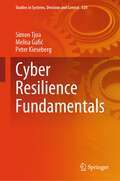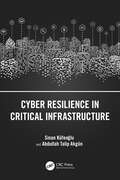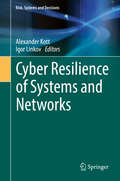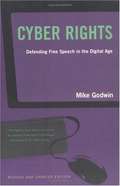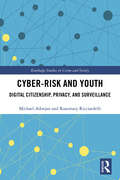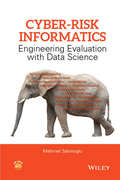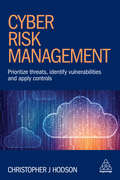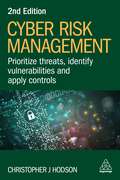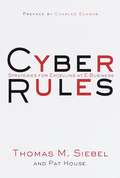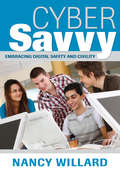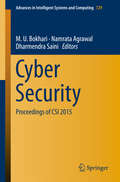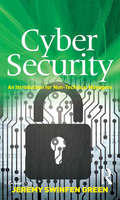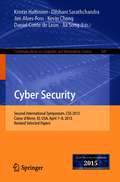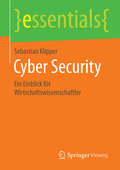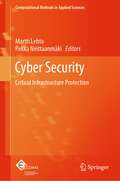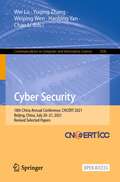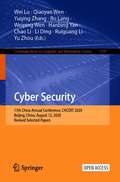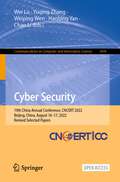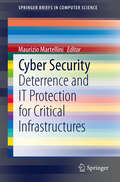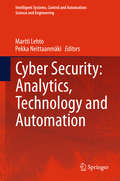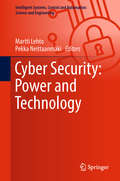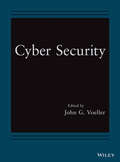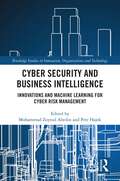- Table View
- List View
Cyber Resilience Fundamentals (Studies in Systems, Decision and Control #520)
by Simon Tjoa Melisa Gafić Peter KiesebergThis book provides readers with the necessary capabilities to meet the challenge of building and testing resilient IT services. Upon introducing the fundamentals of cyber resilience with important international standards and best practices, and the risk management process, the book covers in detail the cyber resilience management process. Here, it gives insights into the principles and design criteria to build cyber resilience in organizations, and to integrate it into operations to contribute to incident preparedness. Further, it describes measures for incident handling, including detection, containment, and post-incident handling, and analyses the most critical aspects of cyber resilience testing, such as auditing, exercising, and testing. Written for advanced undergraduate students attending information security and business continuity management courses, this book also addresses researchers and professionals in the broad field of IT Security and cyber resilience.
Cyber Resilience in Critical Infrastructure
by Sinan Küfeoğlu Abdullah Talip AkgünCritical infrastructure sectors are those whose assets, systems, and networks, whether physical or virtual, are deemed so important to nations that their incapacitation or destruction would have a crippling effect on national security, national economic security, national public health or safety, or any combination of these. Each country might define their unique critical infrastructure. In this book, we compiled nine critical infrastructure sectors: Emergency Services, Energy, Finance, Food, Government, Health, Telecommunications, Transport, and Water. The continuity of services in these sectors is vital for the daily lives of societies and economies. This study introduces 49 case studies from various parts of the world. This book investigates Cyber Resilience in Critical Infrastructure by paying attention to recommending a national-level cyber resilience framework for all nations to use. Furthermore, we present sectoral analysis and case studies for each infrastructure by going through an in-depth analysis. As military tensions grow in many parts of the world, nations are alarmed and focused on their national cyber resilience, especially the reliability of their critical infrastructure. We believe this book will be a popular reference and guidebook for a wide range of readers worldwide, from governments to policymakers, from industry to the finance sector, and many others.
Cyber Resilience of Systems and Networks (Risk, Systems and Decisions)
by Igor Linkov Alexander KottThis book introduces fundamental concepts of cyber resilience, drawing expertise from academia, industry, and government. Resilience is defined as the ability to recover from or easily adjust to shocks and stresses. Unlike the concept of security - which is often and incorrectly conflated with resilience -- resilience refers to the system's ability to recover or regenerate its performance after an unexpected impact produces a degradation in its performance. A clear understanding of distinction between security, risk and resilience is important for developing appropriate management of cyber threats. The book presents insightful discussion of the most current technical issues in cyber resilience, along with relevant methods and procedures. Practical aspects of current cyber resilience practices and techniques are described as they are now, and as they are likely to remain in the near term.The bulk of the material is presented in the book in a way that is easily accessible to non-specialists. Logical, consistent, and continuous discourse covering all key topics relevant to the field will be of use as teaching material as well as source of emerging scholarship in the field. A typical chapter provides introductory, tutorial-like material, detailed examples, in-depth elaboration of a selected technical approach, and a concise summary of key ideas.
Cyber Rights: Defending Free Speech in the Digital Age
by Mike GodwinLawyer and writer Mike Godwin has been at the forefront of the struggle to preserve freedom of speech on the Internet. In Cyber Rights he recounts the major cases and issues in which he was involved and offers his views on free speech and other constitutional rights in the digital age. Godwin shows how the law and the Constitution apply, or should apply, in cyberspace and defends the Net against those who would damage it for their own purposes. Godwin details events and phenomena that have shaped our understanding of rights in cyberspace--including early antihacker fears that colored law enforcement activities in the early 1990s, the struggle between the Church of Scientology and its critics on the Net, disputes about protecting copyrighted works on the Net, and what he calls "the great cyberporn panic." That panic, he shows, laid bare the plans of those hoping to use our children in an effort to impose a new censorship regime on what otherwise could be the most liberating communications medium the world has seen. Most important, Godwin shows how anyone--not just lawyers, journalists, policy makers, and the rich and well connected--can use the Net to hold media and political institutions accountable and to ensure that the truth is known.
Cyber-risk and Youth: Digital Citizenship, Privacy and Surveillance (Routledge Studies in Crime and Society)
by Michael Adorjan Rosemary RicciardelliCyber-risks are moving targets and societal responses to combat cyber-victimization are often met by the distrust of young people. Drawing on original research, this book explores how young people define, perceive, and experience cyber-risks, how they respond to both the messages they are receiving from society regarding their safety online, and the various strategies and practices employed by society in regulating their online access and activities. This book complements existing quantitative examinations of cyberbullying assessing its extent and frequency, but also aims to critique and extend knowledge of how cyber-risks such as cyberbullying are perceived and responded to. Following a discussion of their methodology and their experiences of conducting research with teens, the authors discuss the social network services that teens are using and what they find appealing about them, and address teens’ experiences with and views towards parental and school-based surveillance. The authors then turn directly to areas of concern expressed by their participants, such as relational aggression, cyberhacking, privacy, and privacy management, as well as sexting. The authors conclude by making recommendations for policy makers, educators and teens – not only by drawing from their own theoretical and sociological interpretations of their findings, but also from the responses and recommendations given by their participants about going online and tackling cyber-risk. One of the first texts to explore how young people respond to attempts to regulate online activity, this book will be key reading for those involved in research and study surrounding youth crime, cybercrime, youth culture, media and crime, and victimology – and will inform those interested in addressing youth safety online how to best approach what is often perceived as a sensitive and volatile social problem.
Cyber-Risk Informatics: Engineering Evaluation with Data Science
by Mehmet SahinogluThis book provides a scientific modeling approach for conducting metrics-based quantitative risk assessments of cybersecurity vulnerabilities and threats. This book provides a scientific modeling approach for conducting metrics-based quantitative risk assessments of cybersecurity threats. The author builds from a common understanding based on previous class-tested works to introduce the reader to the current and newly innovative approaches to address the maliciously-by-human-created (rather than by-chance-occurring) vulnerability and threat, and related cost-effective management to mitigate such risk. This book is purely statistical data-oriented (not deterministic) and employs computationally intensive techniques, such as Monte Carlo and Discrete Event Simulation. The enriched JAVA ready-to-go applications and solutions to exercises provided by the author at the book's specifically preserved website will enable readers to utilize the course related problems. * Enables the reader to use the book's website's applications to implement and see results, and use them making 'budgetary' sense * Utilizes a data analytical approach and provides clear entry points for readers of varying skill sets and backgrounds * Developed out of necessity from real in-class experience while teaching advanced undergraduate and graduate courses by the author Cyber-Risk Informatics is a resource for undergraduate students, graduate students, and practitioners in the field of Risk Assessment and Management regarding Security and Reliability Modeling. Mehmet Sahinoglu, a Professor (1990) Emeritus (2000), is the founder of the Informatics Institute (2009) and its SACS-accredited (2010) and NSA-certified (2013) flagship Cybersystems and Information Security (CSIS) graduate program (the first such full degree in-class program in Southeastern USA) at AUM, Auburn University's metropolitan campus in Montgomery, Alabama. He is a fellow member of the SDPS Society, a senior member of the IEEE, and an elected member of ISI. Sahinoglu is the recipient of Microsoft's Trustworthy Computing Curriculum (TCC) award and the author of Trustworthy Computing (Wiley, 2007).
Cyber Risk Management: Prioritize Threats, Identify Vulnerabilities and Apply Controls
by Christopher HodsonMost organizations are undergoing a digital transformation of some sort and are looking to embrace innovative technology, but new ways of doing business inevitably lead to new threats which can cause irreparable financial, operational and reputational damage. In an increasingly punitive regulatory climate, organizations are also under pressure to be more accountable and compliant. Cyber Risk Management clearly explains the importance of implementing a cyber security strategy and provides practical guidance for those responsible for managing threat events, vulnerabilities and controls, including malware, data leakage, insider threat and Denial-of-Service. Examples and use cases including Yahoo, Facebook and TalkTalk, add context throughout and emphasize the importance of communicating security and risk effectively, while implementation review checklists bring together key points at the end of each chapter. Cyber Risk Management analyzes the innate human factors around risk and how they affect cyber awareness and employee training, along with the need to assess the risks posed by third parties. Including an introduction to threat modelling, this book presents a data-centric approach to cyber risk management based on business impact assessments, data classification, data flow modelling and assessing return on investment. It covers pressing developments in artificial intelligence, machine learning, big data and cloud mobility, and includes advice on responding to risks which are applicable for the environment and not just based on media sensationalism.
Cyber Risk Management: Prioritize Threats, Identify Vulnerabilities and Apply Controls
by Christopher J HodsonHow can you manage the complex threats that can cause financial, operational and reputational damage to the business? This practical guide shows how to implement a successful cyber security programme. The second edition of Cyber Risk Management covers the latest developments in cyber security for those responsible for managing threat events, vulnerabilities and controls. These include the impact of Web3 and the metaverse on cyber security, supply-chain security in the gig economy and exploration of the global, macroeconomic conditions that affect strategies. It explains how COVID-19 and remote working changed the cybersecurity landscape.Cyber Risk Management presents a data-centric approach to cyber risk management based on business impact assessments, data classification, data flow modelling and assessing return on investment. It covers pressing developments in artificial intelligence, machine learning, big data and cloud mobility, and includes advice on dealing with malware, data leakage, insider threat and Denial-of-Service. With analysis on the innate human factors affecting cyber risk and awareness and the importance of communicating security effectively, this book is essential reading for all risk and cybersecurity professionals.
Cyber Risks for Business Professionals
by Rupert KendrickRealise the benefits of Internet technologies, while ensuring your company is protected from the associated risks!An effective risk management strategy is vital to your company's survival Internet technologies have revolutionised the way that business is conducted. However, these innovations expose your business to various risks. Inadequate security can lead to the theft of customer data and, in the event of technological failure or a cyberattack, your business could lose its ability to function altogether. An effective risk management strategy is, therefore, vital to your company's survival. Understand the origins of cyber risks and develop suitable strategies for their management Cyber Risks for Business Professionals: A Management Guide is a general guide to the origins of cyber risks and to developing suitable strategies for their management. It provides a breakdown of the main risks involved and shows you how to manage them. Covering the relevant legislation on information security and data protection, the author combines his legal expertise with a solid, practical grasp of the latest developments in IT to offer a comprehensive overview of a highly complex subject. Expert guidance examining the operational and technological risks Drawing on interviews with experts from Clifford Chance, Capgemini and Morgan Stanley amongst others, the book examines the operational and technological risks alongside the legal and compliance issues. This book will be invaluable to lawyers and accountants, as well as to company directors and business professionals. Benefits to business include: * Understand and manage the technological risks This book looks at the security issues surrounding Cloud computing, and highlights the problems that have arisen as a result of the use of laptop computers and memory sticks for remote working. Implementing a risk management framework will offer reassurance to your existing customers and improve your chances of winning new business. * Familiarise yourself with the legal issues You need to be aware of the laws that govern your activities when you do business online. The author offers you a guide to the most important aspects of IT law, and outlines the implications of recent legislation. The author also looks at the compliance requirements of PCI DSS (the Payment Card Industry Data Security Standard). * Control employee use of Web 2. 0 technologies While sites such as Facebook and LinkedIn help people to develop business contacts, employee misuse of social networking sites also causes problems, ranging from damage to the company's reputation to breaches of commercial confidentiality. This book offers advice on the right policy to adopt to ensure your staff use Web 2. 0 technologies responsibly. * Use technology to address the risks This book introduces you to IT solutions that you can deploy to improve your information security, such as encryption and digital watermarking. It also looks at how you can monitor and control e-mail to prevent the leaking of sensitive information.
Cyber Rules: Strategies for Excelling at E-Business
by Thomas M. Siebel Pat HouseThe book is about the dos and don'ts when doing the business through the Internet. It also has an overview of how the Internet opens new possibilities for business, in a nontechnical language.
Cyber Savvy: Embracing Digital Safety and Civility
by Dr Nancy E. WillardHow to teach students online safety and citizenship Nancy Willard integrates her expertise in risk prevention, law, and education to provide a collaborative and positive process for teaching secondary students positive social norms, safety, and “netiquette.” She lays out the steps for school staff and students to work as a team in building an effective program that will teach young people how to: Keep themselves safe Disclose and consume information wisely Respect the rights, privacy, and property of others Take responsibility for others’ well-being when needed Respond to inappropriate or dangerous situations
Cyber Security: Proceedings Of Csi 2015 (Advances In Intelligent Systems And Computing #729)
by M. U. Bokhari Namrata Agrawal Dharmendra SainiThis book comprises select proceedings of the annual convention of the Computer Society of India. Divided into 10 topical volumes, the proceedings present papers on state-of-the-art research, surveys, and succinct reviews. The volume covers diverse topics ranging from information security to cryptography and from encryption to intrusion detection. This book focuses on Cyber Security. It aims at informing the readers about the technology in general and the internet in particular. The book uncovers the various nuances of information security, cyber security and its various dimensions. This book also covers latest security trends, ways to combat cyber threats including the detection and mitigation of security threats and risks. The contents of this book will prove useful to professionals and researchers alike.
Cyber Security: An Introduction for Non-Technical Managers
by Jeremy Swinfen GreenCyber security involves protecting organisations from cyber risks, the threats to organisations caused by digital technology. These risks can cause direct damage to revenues and profits as well as indirect damage through reduced efficiency, lower employee morale, and reputational damage. Cyber security is often thought to be the domain of specialist IT professionals however, cyber risks are found across and within organisations. Unfortunately, many managers outside IT feel they are ill equipped to deal with cyber risks and the use of jargon makes the subject especially hard to understand. For this reason cyber threats are worse than they really need to be. The reality is that the threat from cyber risks is constantly growing, thus non-technical managers need to understand and manage it. As well as offering practical advice, the author guides readers through the processes that will enable them to manage and mitigate such threats and protect their organisations.
Cyber Security: Second International Symposium, CSS 2015, Coeur d'Alene, ID, USA, April 7-8, 2015, Revised Selected Papers (Communications in Computer and Information Science #589)
by Kristin Haltinner Dilshani Sarathchandra Jim Alves-Foss Kevin Chang Daniel Conte de Leon Jia SongThis book constitutes the refereed proceedings of the Second International Symposium on Cyber Security, CSS 2015, held in Coeur d'Alene, ID, USA, in April 2015. The 9 revised full papers presented were carefully reviewed and selected from 20 papers. The papers reflect four areas of scholarly work: permissions and trust evaluation, implementation and management; cloud and device security and privacy; social implications of networked and mobile applications; system and process assessments for improved cybersecurity.
Cyber Security: Ein Einblick für Wirtschaftswissenschaftler (essentials)
by Sebastian KlipperIn diesem Buch erfahren Wirtschaftswissenschaftler, wie Firmen nach Hackerangriffen vom Markt verschwinden und wie Hacker Aktienkurse beeinflussen können. Lernen Sie, wie Homo oeconomicus beim Thema Cyber Security zum Homo carens securitate wird und wie es gelingt, mithilfe der wirtschaftswissenschaftlichen ,,Brille" (oder: Perspektive/Sicht) ganz neue Lösungsansätze und Sichtweisen im Kampf gegen Wirtschaftsspione, Hacker und Cyber-Kriminelle zu erkennen. Cyber Security bzw. IT-Sicherheit ist ein Zukunftsthema, an dem kaum jemand vorbeikommt. Dieses Buch beschreibt anhand aktueller Vorfälle - ohne technisches Grundwissen vorauszusetzen -, was Ökonomen wissen müssen, um sich am Gespräch über eines der wichtigsten Zukunftsthemen unserer Zeit beteiligen zu können.
Cyber Security: Critical Infrastructure Protection (Computational Methods in Applied Sciences #56)
by Martti Lehto Pekka NeittaanmäkiThis book focus on critical infrastructure protection. The chapters present detailed analysis of the issues and challenges in cyberspace and provide novel solutions in various aspects. The first part of the book focus on digital society, addressing critical infrastructure and different forms of the digitalization, strategic focus on cyber security, legal aspects on cyber security, citizen in digital society, and cyber security training. The second part focus on the critical infrastructure protection in different areas of the critical infrastructure. The chapters cover the cybersecurity situation awareness, aviation and air traffic control, cyber security in smart societies and cities, cyber security in smart buildings, maritime cyber security, cyber security in energy systems, and cyber security in healthcare. The third part presents the impact of new technologies upon cyber capability building as well as new challenges brought about by new technologies. These new technologies are among others are quantum technology, firmware and wireless technologies, malware analysis, virtualization.
Cyber Security: 18th China Annual Conference, CNCERT 2021, Beijing, China, July 20–21, 2021, Revised Selected Papers (Communications in Computer and Information Science #1506)
by Wei Lu Chao Li Weiping Wen Hanbing Yan Yuqing ZhangThis open access book constitutes the refereed proceedings of the 17th International Annual Conference on Cyber Security, CNCERT 2021, held in Beijing, China, in AJuly 2021. The 14 papers presented were carefully reviewed and selected from 51 submissions. The papers are organized according to the following topical sections: data security; privacy protection; anomaly detection; traffic analysis; social network security; vulnerability detection; text classification.
Cyber Security: 17th China Annual Conference, CNCERT 2020, Beijing, China, August 12, 2020, Revised Selected Papers (Communications in Computer and Information Science #1299)
by Wei Lu Qiaoyan Wen Yuqing Zhang Bo Lang Weiping Wen Hanbing Yan Chao Li Li Ding Ruiguang Li Yu ZhouThis open access book constitutes the refereed proceedings of the 16th International Annual Conference on Cyber Security, CNCERT 2020, held in Beijing, China, in August 2020. The 17 papers presented were carefully reviewed and selected from 58 submissions. The papers are organized according to the following topical sections: access control; cryptography; denial-of-service attacks; hardware security implementation; intrusion/anomaly detection and malware mitigation; social network security and privacy; systems security.
Cyber Security: 19th China Annual Conference, CNCERT 2022, Beijing, China, August 16–17, 2022, Revised Selected Papers (Communications in Computer and Information Science #1699)
by Wei Lu Yuqing Zhang Weiping Wen Hanbing Yan Chao LiThis open access book constitutes the refereed proceedings of the 18th China Annual Conference on Cyber Security, CNCERT 2022, held in Beijing, China, in August 2022. The 17 papers presented were carefully reviewed and selected from 64 submissions. The papers are organized according to the following topical sections: data security; anomaly detection; cryptocurrency; information security; vulnerabilities; mobile internet; threat intelligence; text recognition.
Cyber Security: Deterrence and IT Protection for Critical Infrastructures (SpringerBriefs in Computer Science)
by Maurizio MartelliniThe experts of the International Working Group-Landau Network Centro Volta (IWG-LNCV) discuss aspects of cyber security and present possible methods of deterrence, defense and resilience against cyber attacks. This SpringerBrief covers state-of-the-art documentation on the deterrence power of cyber attacks and argues that nations are entering a new cyber arms race. The brief also provides a technical analysis of possible cyber attacks towards critical infrastructures in the chemical industry and chemical safety industry. The authors also propose modern analyses and a holistic approach to resilience and security of Industrial Control Systems. The combination of contextual overview and future directions in the field makes this brief a useful resource for researchers and professionals studying systems security, data security and data structures. Advanced-level students interested in data security will also find this brief a helpful guide to recent research.
Cyber Security: Analytics, Technology and Automation (Intelligent Systems, Control and Automation: Science and Engineering #78)
by Pekka Neittaanmäki Martti LehtoThe book, in addition to the cyber threats and technology, processes cyber security from many sides as a social phenomenon and how the implementation of the cyber security strategy is carried out. The book gives a profound idea of the most spoken phenomenon of this time. The book is suitable for a wide-ranging audience from graduate to professionals/practitioners and researchers. Relevant disciplines for the book are Telecommunications / Network security, Applied mathematics / Data analysis, Mobile systems / Security, Engineering / Security of critical infrastructure and Military science / Security.
Cyber Security: Power and Technology (Intelligent Systems, Control and Automation: Science and Engineering #93)
by Pekka Neittaanmäki Martti LehtoThis book gathers the latest research results of scientists from different countries who have made essential contributions to the novel analysis of cyber security. Addressing open problems in the cyber world, the book consists of two parts. Part I focuses on cyber operations as a new tool in global security policy, while Part II focuses on new cyber security technologies when building cyber power capabilities. The topics discussed include strategic perspectives on cyber security and cyber warfare, cyber security implementation, strategic communication, trusted computing, password cracking, systems security and network security among others.
Cyber Security
by John G. VoellerCyber Security features articles from the Wiley Handbook of Science and Technology for Homeland Security covering topics related to cyber security metrics and measure and related technologies that meet security needs. Specific applications to web services, the banking and the finance sector, and industrial process control systems are discussed.
Cyber Security and Business Intelligence: Innovations and Machine Learning for Cyber Risk Management (Routledge Studies in Innovation, Organizations and Technology)
by Mohammad Zoynul Abedin Petr HajekTo cope with the competitive worldwide marketplace, organizations rely on business intelligence to an increasing extent. Cyber security is an inevitable practice to protect the entire business sector and its customer. This book presents the significance and application of cyber security for safeguarding organizations, individuals’ personal information, and government. The book provides both practical and managerial implications of cyber security that also supports business intelligence and discusses the latest innovations in cyber security. It offers a roadmap to master degree students and PhD researchers for cyber security analysis in order to minimize the cyber security risk and protect customers from cyber-attack. The book also introduces the most advanced and novel machine learning techniques including, but not limited to, Support Vector Machine, Neural Networks, Extreme Learning Machine, Ensemble Learning, and Deep Learning Approaches, with a goal to apply those to cyber risk management datasets. It will also leverage real-world financial instances to practise business product modelling and data analysis. The contents of this book will be useful for a wide audience who are involved in managing network systems, data security, data forecasting, cyber risk modelling, fraudulent credit risk detection, portfolio management, and data regulatory bodies. It will be particularly beneficial to academics as well as practitioners who are looking to protect their IT system, and reduce data breaches and cyber-attack vulnerabilities.
Cyber Security and Business Intelligence: Innovations and Machine Learning for Cyber Risk Management (Routledge Studies in Innovation, Organizations and Technology)
by Mohammad Zoynul Abedin Petr HajekTo cope with the competitive worldwide marketplace, organizations rely on business intelligence to an increasing extent. Cyber security is an inevitable practice to protect the entire business sector and its customer. This book presents the significance and application of cyber security for safeguarding organizations, individuals’ personal information, and government.The book provides both practical and managerial implications of cyber security that also supports business intelligence and discusses the latest innovations in cyber security. It offers a roadmap to master degree students and PhD researchers for cyber security analysis in order to minimize the cyber security risk and protect customers from cyber-attack. The book also introduces the most advanced and novel machine learning techniques including, but not limited to, Support Vector Machine, Neural Networks, Extreme Learning Machine, Ensemble Learning, and Deep Learning Approaches, with a goal to apply those to cyber risk management datasets. It will also leverage real-world financial instances to practise business product modelling and data analysis.The contents of this book will be useful for a wide audience who are involved in managing network systems, data security, data forecasting, cyber risk modelling, fraudulent credit risk detection, portfolio management, and data regulatory bodies. It will be particularly beneficial to academics as well as practitioners who are looking to protect their IT system, and reduce data breaches and cyber-attack vulnerabilities.
